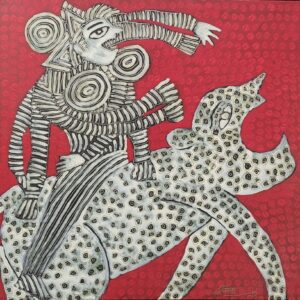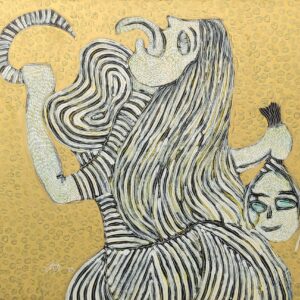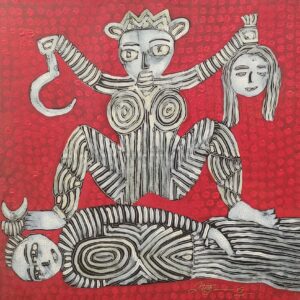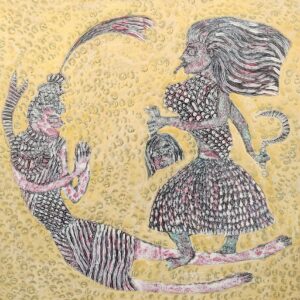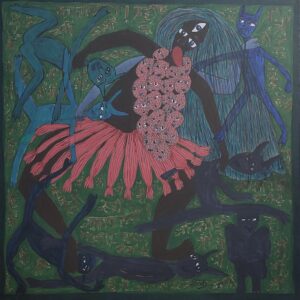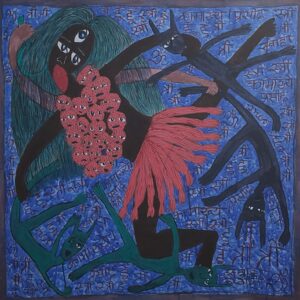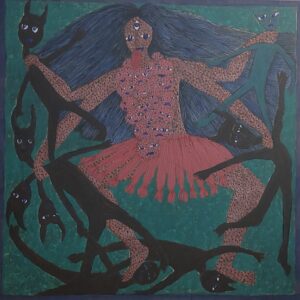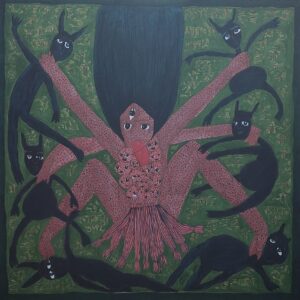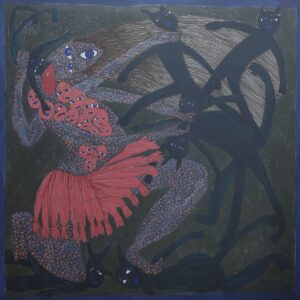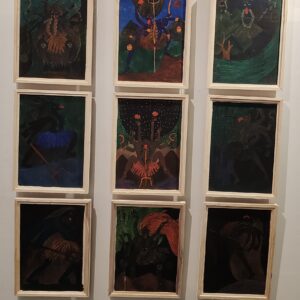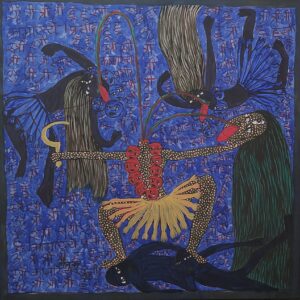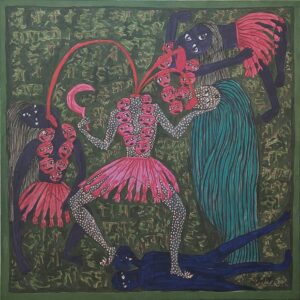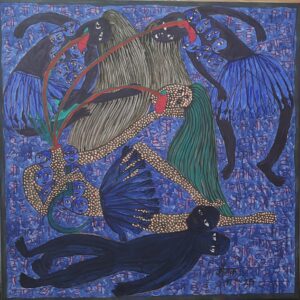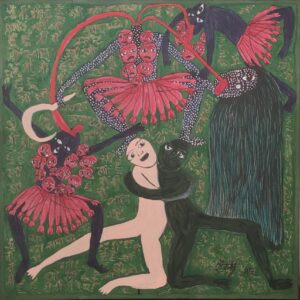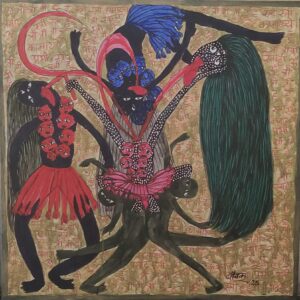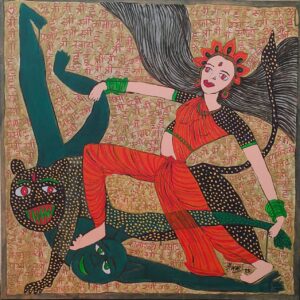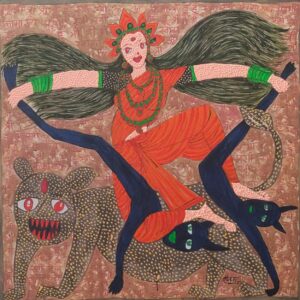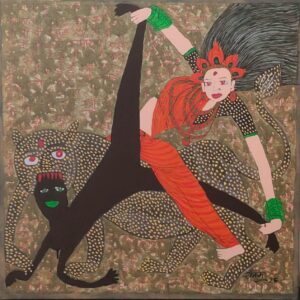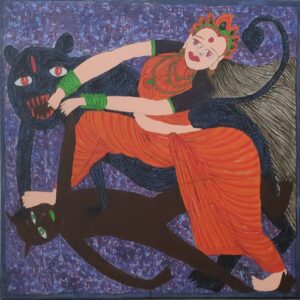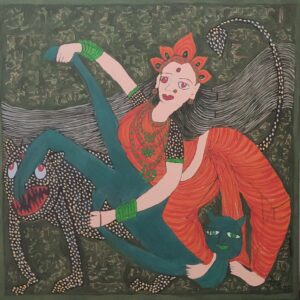Figurative and Creative Paintings
Here You can find my all-figurative paintings, Paintings based on Ramayana, Mahabharat, Ved, Purana etc. Paintings based on Hindu Mythology. Paintings based on Sex, Society and Crime. Nude Figures, Figure Study and Figurative Composition but not Realistic. And find my Semi Figurative and Creative paintings.
The Living Figure: Rounak Rai Nirmohi’s Journey Through Figurative Art
In the expansive universe of contemporary Indian art, Rounak Rai Nirmohi’s figurative paintings and drawings stand out for their emotional honesty, thematic depth, and aesthetic clarity. These works do not belong to a single tradition or category; rather, they embody a continuous dialogue between form, story, and spirit. Rooted in classical Indian narratives yet deeply responsive to modern society, his figurative series bridges timeless cultural values and present-day consciousness.
This body of work is distinct from his Tantra series. Here, the figure is not a vehicle for metaphysical energy or cosmic union. Instead, it becomes a vessel for emotion, memory, mythology, beauty, awareness, and critique. Whether he paints a goddess, a victim of crime, a nude form, or an environmental message, each line carries intent—both poetic and political.
—
The Figure as Mirror and Message
Rounak’s figurative art explores the human body and form not only for its beauty but for its symbolic power. His nude drawings and paintings do not conform to voyeuristic traditions—they radiate a quiet dignity, innocence, and strength. The body is shown not just in its physicality but in its emotional and spiritual presence. In this way, Nirmohi honors the body as both vulnerable and powerful, personal and universal.
His mythological figures—such as Durga, Kali, Mahisasurmardini, and others—are rendered with a folk-like simplicity but layered with psychological intensity. These deities are not distant icons but emotive, expressive beings, caught in moments of victory, rage, compassion, or transformation. Likewise, his figures from the Ramayana are not heroic in the conventional sense but are full of human complexity—sometimes comic, sometimes tragic, always honest.
—
Figurative Art as Social Awareness
What gives Rounak’s figurative work a unique edge is its deep engagement with society. His paintings based on social awareness themes—like crime against women, environmental degradation, mental health, and the COVID-19 pandemic—serve as visual essays. Through human figures, he exposes wounds, pleads for compassion, and calls for change.
In crime-based compositions, he reveals the psychology of violence, its emotional toll, and its moral consequences.
His paintings for mental health awareness use broken postures, quiet gazes, and symbolic textures to show isolation, pain, and inner struggle.
In his environmental works, human figures are often entwined with trees, water, animals, or depicted suffocating in polluted spaces, making the body itself a battlefield of survival.
These drawings and paintings are not documentary in nature—they are symbolic, interpretive, and emotionally resonant. Their power lies not in literal representation but in evocative storytelling.
—
Signature Style: Simplicity with Soul
Across his figurative series, Nirmohi remains loyal to a visual language that is recognizably his own:
Folk-inspired forms with a child-like purity
Multi-figure compositions that feel like visual narratives or dramatic scenes
A soft, fresh color palette, full of emotional warmth
Use of textures and tonal balance to guide attention to dominant characters or themes
Emphasis on expression, gesture, and symbolic placement over anatomical realism
Despite their simplicity, these figures are never superficial. They are emotionally loaded, sometimes humorous, sometimes disturbing, and always inviting the viewer into deeper reflection.
—
Beyond Religion, Beyond Tantra
Unlike his Tantra Series—which explores spiritual transformation through sexual energy—this body of work engages the material, emotional, and moral world more directly. While spiritual undercurrents remain, these works do not follow Tantric discipline or metaphysics. Instead, they focus on:
Storytelling (illustrated tales from epics, folklore, and daily life)
Social critique (from hypersexual media culture to ecological ruin)
Empathy through the body (how posture, gaze, and gesture can express inner life)
This distinction is important. While both series reflect Rounak Rai’s deep introspection and philosophical engagement, the figurative works speak more to collective human experience, accessible to all, regardless of spiritual background.
—
Conclusion: The Power of the Human Form
Rounak Rai Nirmohi’s figurative paintings and drawings reflect a belief that the human body holds stories far beyond language. Whether it’s a divine warrior, a violated soul, a solitary nude, or a nature-bound villager, his figures are never passive. They speak, question, and illuminate.
In a time when image-making is often reduced to spectacle, Rounak’s figures resist. They invite. They connect. They make us pause and feel. They remind us that within every figure—mythical or mundane—lies a message, a mirror, and sometimes, a revolution.
Showing 1–20 of 36 results
-
Durga
Original price was: ₹100,000.00.₹95,000.00Current price is: ₹95,000.00. -
Kali 1
Original price was: ₹100,000.00.₹95,000.00Current price is: ₹95,000.00. -
Kali 2
Original price was: ₹100,000.00.₹95,000.00Current price is: ₹95,000.00. -
Kali 3
Original price was: ₹100,000.00.₹95,000.00Current price is: ₹95,000.00. -
Kali Mata 1 Acrylic on Canvas 3×3 feet
Original price was: ₹100,000.00.₹95,000.00Current price is: ₹95,000.00. -
Kali Mata 2 Acrylic on Canvas 3X3 feet
Original price was: ₹100,000.00.₹95,000.00Current price is: ₹95,000.00. -
Kali Mata 3 Acrylic on Canvas 3X3 feet
Original price was: ₹100,000.00.₹95,000.00Current price is: ₹95,000.00. -
Kali Mata 4 Acrylic on Canvas 3X3 feet
Original price was: ₹100,000.00.₹95,000.00Current price is: ₹95,000.00. -
Kali Mata 5 Acrylic on Canvas 3X3 feet
Original price was: ₹100,000.00.₹95,000.00Current price is: ₹95,000.00. -
Kali Mata Panel Watercolor on Paper 6X4 feet
Original price was: ₹500,000.00.₹450,000.00Current price is: ₹450,000.00. -
Maa Chhindmastika 1 Acrylic on Canvas 3X3 feet
Original price was: ₹100,000.00.₹95,000.00Current price is: ₹95,000.00. -
Maa Chhindmastika 2 Acrylic on Canvas 3X3 feet
Original price was: ₹100,000.00.₹95,000.00Current price is: ₹95,000.00. -
Maa Chhindmastika 3 Acrylic on Canvas 3X3 feet
Original price was: ₹100,000.00.₹95,000.00Current price is: ₹95,000.00. -
Maa Chhindmastika 4 Acrylic on Canvas 3X3 feet
Original price was: ₹100,000.00.₹95,000.00Current price is: ₹95,000.00. -
Maa Chhindmastika 5 Acrylic on Canvas 3X3 feet
Original price was: ₹100,000.00.₹95,000.00Current price is: ₹95,000.00. -
Maa Durga 1 Mahishasurmardani 3X3 feer Acrylic on Canvas
Original price was: ₹100,000.00.₹95,000.00Current price is: ₹95,000.00. -
Maa Durga 2 Mahishasurmardani 3X3 feer Acrylic on Canvas
Original price was: ₹100,000.00.₹95,000.00Current price is: ₹95,000.00. -
Maa Durga 3 Mahishasurmardani 3X3 feer Acrylic on Canvas
Original price was: ₹100,000.00.₹95,000.00Current price is: ₹95,000.00. -
Maa Durga 4 Mahishasurmardani 3X3 feer Acrylic on Canvas
Original price was: ₹100,000.00.₹95,000.00Current price is: ₹95,000.00. -
Maa Durga 5 Mahishasurmardani 3X3 feer Acrylic on Canvas
Original price was: ₹100,000.00.₹95,000.00Current price is: ₹95,000.00.

